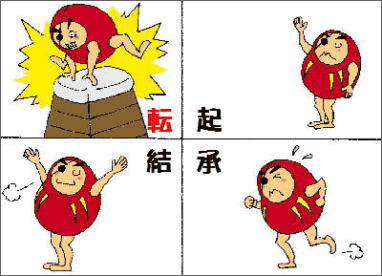Recently there has been a lot of talk about the Japanese education system on Tofugu. One thing to note is that communication, rhetoric, and argumentation are not taught as extensively in Japanese schools and universities as they are in the West. This tends to be one reason Japanese students want to study abroad. Western rhetoric sprung out of a long history of Greek and Roman philosophers like Plato, Socrates, and Cicero, who spent a lot of time arguing about arguments. Japan doesn't really have a comparable rhetorical tradition. Their tradition evolved, like many East-Asian writing styles, from poetry and theater.
The Western standard argumentative style that most of us are sick of from high school—explicitly stated main idea in the first paragraph, and everything else in support of that idea—was traditionally used to give a direct voice of democracy and dissent. Early Greek and Roman orators were infatuated with the idea of individual voices challenging the status quo, something the traditionally-minded Japan was never very keen on. Western rhetoric tends to stress the importance of the individual speaker, but the Japanese, historically, have favored the group mentality. In fact Western argumentative styles can be sometimes seen as offensively direct or arrogant to practitioners of East-Asian writing traditions.

When I was being trained as a University Writing Tutor, these cultural differences were one of the first things we talked about. More often than not if a student has a traditional writing style from a home culture it will clash with the writing norms in a new environment. It's a lot like going from writing a text message or tweet to a ten-page scientific paper—the expectations placed on you are now completely different from what you were just used to (lol unless ur prof is totes malotes into abbrevs). This gets amplified even more if you are trying to write in your second language. In any school with a large pool of international students it's extremely important to keep this in mind.
These contrasting styles provide a real challenge for some Japanese students in the West. Writing-intensive classes will punish students for straying from the typical cultural model of argumentation. Many Asian rhetorical traditions rely on tactfully talking around the topic without explicitly saying the main idea, and some other models follow an "inductive" pattern which starts with support and ends with a main idea. More often than not in a Western classroom these kinds of writing get points taken off for redundancy or improper organization. It's a complicated issue because there aren't necessarily errors with the writing—it's just presented in an unfamiliar way.
In an attempt to understand the differences between Japanese and English-speaking writers, John Hinds, a prominent researcher in the 70's and 80's who is often considered the father of Japanese discourse linguistics (an oddly specific thing to be remembered for), identified a handful of typical rhetorical methods he had encountered in Japan.
Throughout his work, Hinds identified four main rhetorical styles that he often observed in Japanese writing. These systems came to be known as: Return to Baseline, Tempura, Jo-Ha-Kyu, and Kishoutenketsu. I'd like to provide a brief breakdown of each, discuss the differences from the Western writing style, and discuss how, as a Western Writing Tutor, there could be perceived problems with using these writing styles in a Western context.
Return to Baseline Style
The Return to Baseline style is based around revisiting an opinion or idea that the writer introduces early on. The writer will provide several examples of issues that seem unrelated but still refer back to a core idea. These elaborate ideas are often discussed at length before returning back to the "baseline". This has a few similarities with the Western argumentative style in that the controlling idea is introduced early on, usually in the first paragraph, but it differs in that the examples and evidence provided don't attempt to explicitly explain or defend the opinion—they just provide an elaborate example. Compared to the Western style these types of writing can be accused of non sequitur or straying from the topic, even though, in reality, they have a very tight focus. Even if the reader understands that it's focused around a core idea the long examples can be accused of meandering since the very direct Western writing style wants you to get back to the point and quickly!
Tempura Style

The Tempura style is one that Hinds and his colleague, translator Yukata Yutani, have been able to identify often in Japanese newspapers. The tempura style isn't named that way because it's delightfully crunchy (unfortunately) but because, as Yutani, puts it is, "similar to tempura in that the superfluous matter must be removed before the content can be known." It is considered a type of inductive style because it does not mention an opinion or controlling idea until the very last paragraphs. In the beginning the writer gives examples, facts and figures, and supports an argument that the reader won't be made aware of until the very end. Compared to Western writing some of the elaborate examples and support in the early paragraphs can be seen as extraneous. In fact, Yutani when translating newspaper articles from Japanese to English would often omit several of these sections in favor of getting at the "fish" underneath. Yutani has said, "[when translating] the flour must be removed in order to find out the contents—fish. If the fish alone is translated an excellent news story in English is forthcoming."
Jo-Ha-Kyuu Style

The Jo-Ha-Kyuu and Kishoutenketsu styles are both derived from classic Japanese poetry and drama. Jo-Ha-Kyuu can be roughly translated to Jo 序 "beginning," Ha 破 "break," and kyū 急 "rapid." The idea is that a play or poem should begin slowly, build up speed, and end swiftly and with purpose. In Japan, this idea is applied to Kendo, the tea ceremony, and many other traditional art forms beyond just poetry and drama. When applied to Japanese writing in general, this style by far most closely matches the typical Western writing style: an introduction, rising support, and brief conclusion. Maybe we aren't so different after all!
Kishoutenketsu Style

Oh, never mind, maybe we are! The Kishoutenketsu style is distinctly Japanese and was born out of classical art forms just like Jo-Ha-Kyuu. However, this style has almost no Western equivalent. Kishoutenketsu was derived from traditional Chinese four-line poetry. The "Ki" refers to the introduction or kiku 起句, the next section is development or shouku 承句, the third is the twist or tenku 転句, and we end with the kekku 結句 or conclusion. The poet Sanyo Rai gave an elegant example of how this structure functions in a poem:
- Ki 起: The characters are daughters of Itoya in Osaka.
- Shou 承: The eldest daughter is sixteen and the younger one is fourteen.
- Ten 転: Historically in Japan, warriors have killed their enemy with bows and arrows.
- Ketsu 結: However, the daughters of Itoya kill only with their eyes
In the Ki section the main players are established, in the Shou section the information from the Ki section is is elaborated upon and more information is provided. The Ten section brings out an entirely new piece of information that contextualizes the conclusion. Finally, in the Ketsu section the connection between the Ten and the Ki is drawn. This is used to great comedic effect in yonkoma, Japanese four-panel comics, as the additional context can often lead to humorous exaggerations.
The reason this style draws such ire from the Western writing community is because the concluding Ketsu section tends to introduce a new element. In Western rhetoric the conclusion is a place to tie old knowledge together, wrap a little bow around it, and call it quits. It is inadvisable to add a new piece of information in the conclusion of a typical Western piece of writing. This style, however, because it is based on poetry introduces a final, dramatic element in the last section. Because of the fact that the Ki, Ten, and Ketsu sections all introduce new elements, this writing style can be particularly confusing to a Western audience. Western, especially academic, writing is often used to tackle one major topic in a piece of prose and really can't process scaling to three topics—especially if they are given equal weight.
Of course with the trend towards internalization in Japan, Western-style deductive and direct argument is becoming more widespread and widely taught in Japan. Not only that, but just like with Western writing there are probably dozens if not hundreds of other constructions people use, but it is still very interesting to look at a few of the ways writing styles differ around the world. This is just a cursory analysis and I hope to do more articles about writing, and rhetoric in Japan but I desire feedback. In your own experiences have you seen these types of writing styles be prevalent in Japan? Does Hinds' work hold up? Let me know, and thanks a lot for reading.
